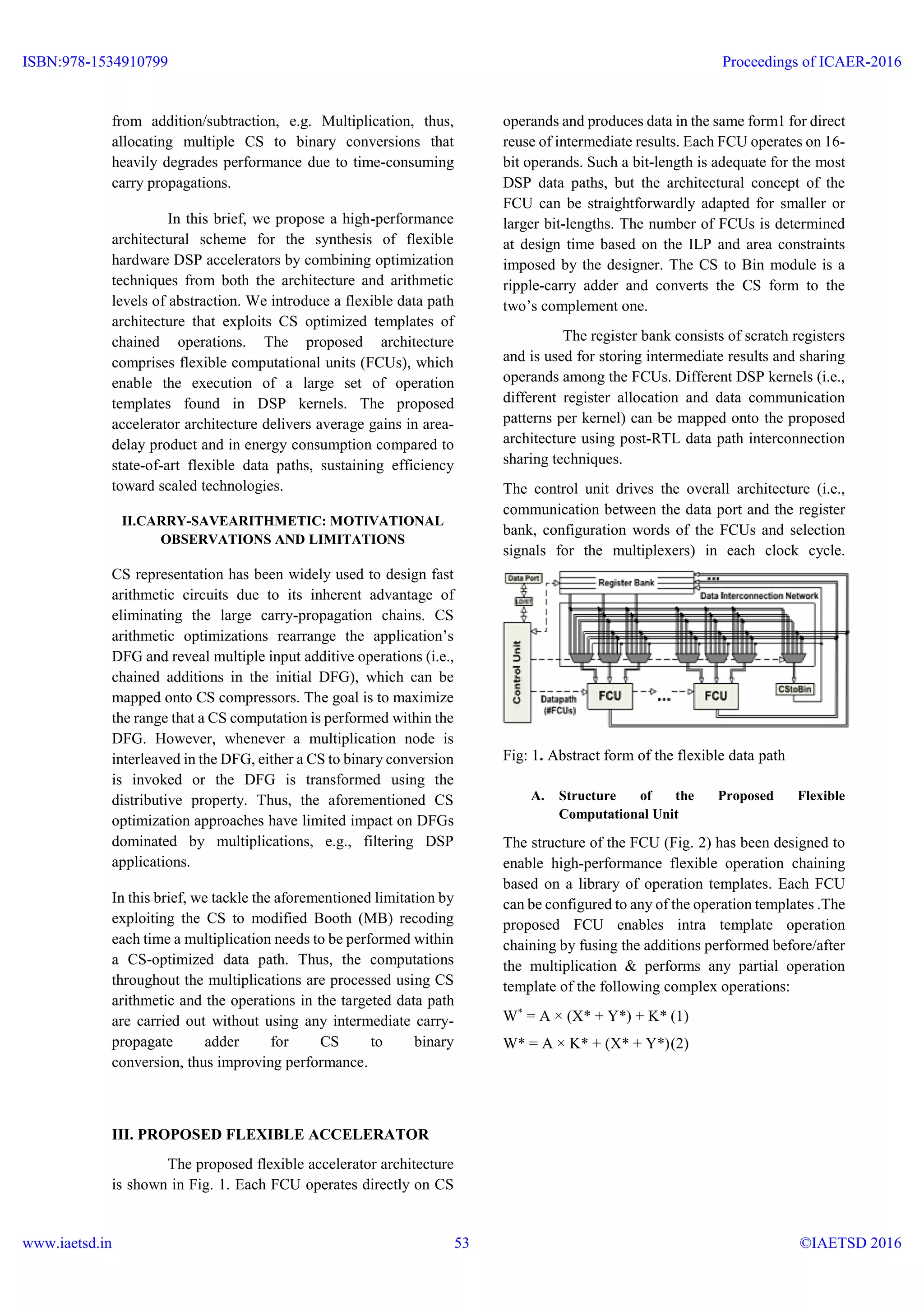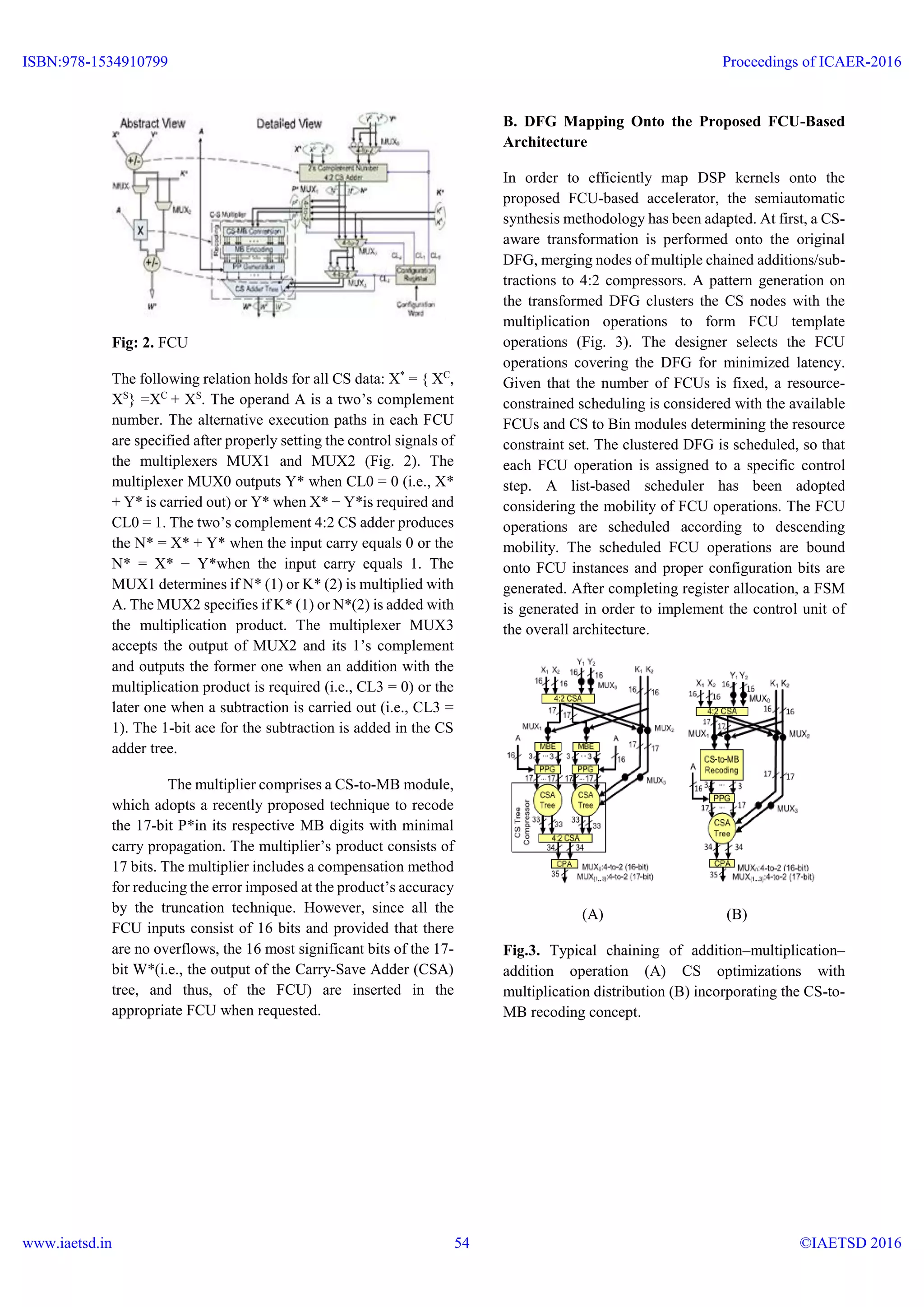This document proposes a flexible accelerator architecture that exploits carry-save arithmetic to efficiently implement digital signal processing kernels. The architecture includes flexible computational units that can be configured to perform chained addition, multiplication, and addition operations directly on carry-save formatted data without intermediate conversions. Experimental results show the proposed architecture delivers average gains of 61.91% in area-delay product and 54.43% in energy consumption compared to state-of-the-art flexible data paths.
![VLSI Architecture for Exploiting Carry-Save Arithmetic Using Verilog HDL Arigila venkata naveen kumar1 yachamaneni Murali2 arigilanaveen@gmail.com1 muraliy85@gmail.com2 1 PG Scholar, Dept of ECE, Audisankara College of Engineering &Technology (Autonomous), Gudur, Nellore, Andhra Pradesh. 2 Assistant professor, Dept of ECE, Audisankara College of Engineering &Technology(Autonomous), Gudur, Nellore, Andhra Pradesh ABSTRACT: Hardware acceleration has been proved an extremely promising implementation strategy for the digital signal processing (DSP) domain. Rather than adopting a monolithic application-specific integrated circuit design approach, in this brief, we present a novel accelerator architecture comprising flexible computational units that support the execution of a large set of operation templates found in DSP kernels. We differentiate from previous works on flexible accelerators by enabling computations to be aggressively performed with carry- save (CS) formatted data. Advanced arithmetic design concepts, i.e., recoding techniques, are utilized enabling CS optimizations to be performed in a larger scope than in previous approaches. Extensive experimental evaluations so what the proposed accelerator architecture delivers average gains of up to 61.91% in area-delay product and 54.43% in energy consumption compared with the state-of-art flexible data paths. Keywords: Arithmetic optimizations, carry-save (CS) form, data path synthesis, flexible accelerator, operation chaining. I. INTRODUCTION Modern embedded systems target high-end application domains requiring efficient implementations of computationally intensive digital signal processing (DSP) functions. The incorporation of heterogeneity through specialized hardware accelerators improves performance and reduces energy consumption [1]. Although application specific integrated circuits (ASICs) form the ideal acceleration solution in terms of performance and power, their inflexibility leads to increased silicon complexity, as multiple instantiated ASICs are needed to accelerate various kernels. Many researchers have proposed the use of domain-specific coarse-grained reconfigurable accelerators in order to increase ASICs’ flexibility without significantly compromising their performance High-performance flexible data paths have been proposed to efficiently map primitive or chained operations found in the initial data- flow graph (DFG) of a kernel. The templates of complex chained operations are either extracted directly from the kernel’s DFG or specified in a predefined behavioral template library. Design decisions on the accelerator’s data path highly impact its efficiency. Existing works on coarse-grained reconfigurable data paths mainly exploit architecture-level optimizations, e.g., increased instruction-level parallelism (ILP). The domain-specific architecture generation algorithms of [5] and [9] vary the type and number of computation units achieving a customized design structure. The flexible architectures were proposed exploiting ILP and operation chaining. Recently aggressive operation chaining is adopted to enable the computation of entire sub expressions using multiple ALUs with heterogeneous arithmetic features. The afore mentioned are configurable architectures exclude arithmetic Optimizations during the architectural synthesis and consider them only at the internal circuit structure of primitive components, e.g., adders, during the logic synthesis. However, research activities have shown that the arithmetic optimizations at higher abstraction levels than the structural circuit one significantly impact on the data path performance. In [10], timing-driven optimizations based on carry- save (CS) arithmetic were performed at the post- Register Transfer Level (RTL) design stage. In [11], common sub expression elimination in CS competitions is used to optimize linear DSP circuits. Verma et al. [12] developed transformation techniques on the application’s DFG to maximize the use of CS arithmetic prior the actual data path synthesis. The aforementioned CS optimization approaches target inflexible data path, i.e., ASIC, implementations. Recently, a flexible architecture combining the ILP and pipelining techniques with the CS-aware operation chaining has been proposed. However, all the aforementioned solutions feature an inherent limitation, i.e., CS optimization is bounded to merging only additions/subtractions. A CS to binary conversion is inserted before each operation that differs ISBN:978-1534910799 www.iaetsd.in Proceedings of ICAER-2016 ©IAETSD 201652](https://image.slidesharecdn.com/iaetsdvlsiarchitectureforexploitingcarry-savearithmeticusingveriloghdl-160630055835/75/Iaetsd-vlsi-architecture-for-exploiting-carry-save-arithmetic-using-verilog-hdl-1-2048.jpg)


![IV. SIMULATION RESULTS Fig:4.RTL Fig: 5.Output Waveform V. CONCLUSION In this brief, we introduced a flexible accelerator architecture that exploits the incorporation of CS arithmetic optimizations to enable fast chaining of additive and multiplicative operations. The proposed flexible accelerator architecture is able to operate on both conventional two’s complement and CS-formatted data operands, thus enabling high degrees of computational density to be achieved. Theoretical and experimental analyses have shown that the proposed solution forms an efficient design tradeoff point delivering optimized latency/area and energy implementations. REFERENCES [1] P. Ienne and R. Leupers, Customizable Embedded Processors: Design Technologies and Applications. San Francisco, CA, USA: Morgan Kaufmann, 2007. [2] P. M. Heysters, G. J. M. Smit, and E. Molenkamp, “A flexible and energy-efficient coarse-grained reconfigurable architecture for mobile systems,” J. Super comput., vol. 26, no. 3, pp. 283–308, 2003. [3] B. Mei, S. Vernalde, D. Verkest, H. D. Man, and R. Lauwereins, “ADRES: An architecture with tightly coupled VLIW processor and coarse-grained reconfigurable matrix,” in Proc. 13th Int. Conf. Field Program. Logic Appl., vol. 2778. 2003, pp. 61–70. [4] M. D. Galanis, G. Theodoridis, S. Tragoudas, and C.E.Goutis,“A high-performance data path for synthesizing DSPkernels,”IEEETrans.Comput.-Aided Design Integr. Circuits Syst., vol. 25, no. 6, pp. 1154– 1162, Jun. 2006. [5] K. Compton and S. Hauck, “Automatic design of reconfigurable domain specific flexible cores,” IEEE Trans. Very Large Scale Integr. (VLSI)Syst., vol. 16, no. 5, pp. 493–503, May 2008. [6] S. Xydis, G. Economakos, and K. Pekmestzi, “Designing coarse-grain reconfigurable architectures by in lining flexibility into custom arithmetic data- paths,“Integr., VLSI J., vol. 42, no. 4, pp. 486–503, Sep. 2009. [7] S. Xydis, G. Economakos, D. Soudris, and K. Pekmestzi, “High performance and area efficient flexible DSP data path synthesis,” IEEE Trans.Very Large Scale Integr. (VLSI) Syst., vol. 19, no. 3, pp. 429– 442, Mar. 2011. [8] G. Ansaloni, P. Bonzini, and L. Pozzi, “EGRA: A coarse grained reconfigurable architectural template,” IEEE Trans. Very Large ScaleIntegr. (VLSI) Syst., vol. 19, no. 6, pp. 1062–1074, Jun. 2011. ISBN:978-1534910799 www.iaetsd.in Proceedings of ICAER-2016 ©IAETSD 201655](https://image.slidesharecdn.com/iaetsdvlsiarchitectureforexploitingcarry-savearithmeticusingveriloghdl-160630055835/75/Iaetsd-vlsi-architecture-for-exploiting-carry-save-arithmetic-using-verilog-hdl-4-2048.jpg)
![[9] M. Stojilovic, D. Novo, L. Saranovac, P. Brisk, and P.Ienne,“Selectiveflexibility: Creating domain-specific reconfigurable arrays,”IEEETrans. Comput.-Aided Design Integr. Circuits Syst., vol. 32, no.5, pp.681–694,May 2013. [10] T. Kim and J. Um, “A practical approach to the synthesis of arithmetic circuits using carry-save- adders,” IEEE Trans. Comput.-Aided Design Integr. CircuitsSyst., vol.19, no.5, pp.615–624,May 2000. [11] A. Hosangadi, F. Fallah, and R. Kastner, “Optimizinghighspeedarithmetic circuits using three- terme xtraction,” in Proc. Design,Autom.Test Eur. (DATE), vol. 1. Mar. 2006, pp. 1–6. [12] A. K. Verma, P. Brisk, and P. Ienne, “Data-flow transformations to maximize the use of carry-save representation in arithmetic circuits,” IEEE Trans. Comput.-Aided Design Integr. Circuits Syst., vol. 27, no. 10, pp. 1761–1774, Oct. 2008. BIOGRAPHIES: Arigila venkata naveen Kumar is currently a PG scholar of VLSI in Audisankara College of Engineering and Technology (Autonomous). He received B.TECH degree from JNTU. His current research interest includes Analysis &VLSI System Design Ph.: 9493012315 Yachamaneni Murali Currently working as Assistant Professor Department of Electronics and Communication engineering in Audisankara College of Engineering and technology (Autonomous),Gudur, Nellore, Andhra Pradesh His current research interest includes VLSI design ISBN:978-1534910799 www.iaetsd.in Proceedings of ICAER-2016 ©IAETSD 201656](https://image.slidesharecdn.com/iaetsdvlsiarchitectureforexploitingcarry-savearithmeticusingveriloghdl-160630055835/75/Iaetsd-vlsi-architecture-for-exploiting-carry-save-arithmetic-using-verilog-hdl-5-2048.jpg)